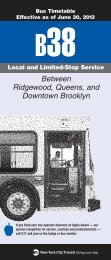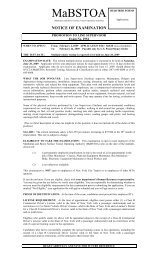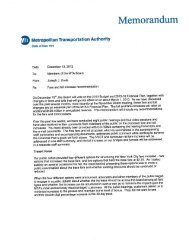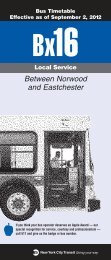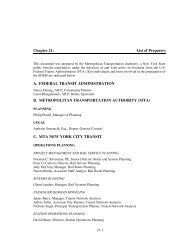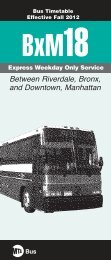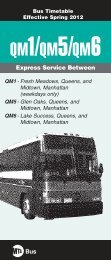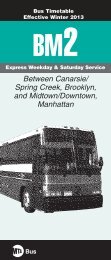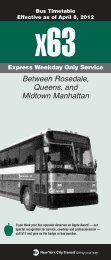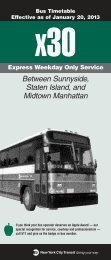Greening Mass Transit & Metro Regions: The Final Report - MTA
Greening Mass Transit & Metro Regions: The Final Report - MTA
Greening Mass Transit & Metro Regions: The Final Report - MTA
Create successful ePaper yourself
Turn your PDF publications into a flip-book with our unique Google optimized e-Paper software.
86<br />
Medium Term: <strong>The</strong>se are high priorities that may take longer to achieve because they require the cooperation of other<br />
agencies.<br />
• Work with NYC DOT and other government agencies to provide bike parking at all railroad train stations and selected<br />
bus and subway stations where the <strong>MTA</strong> does not control the adjacent parking sites.<br />
• Work with NYC DOT and other government agencies to provide signage and safe bicycle access to and from major<br />
transit hubs.<br />
• Work with city agencies to implement a “bike-sharing” program in New York City.<br />
Longer Term: <strong>The</strong>se are priorities that should be planned now for future implementation.<br />
• Design on-board storage facilities for all new trains, buses, and subways.<br />
• Provide passenger-loaded bike racks for the fronts of buses on some routes.<br />
• Promote the use of bicycles as a transit link in TOD and Smart Growth developments throughout the <strong>MTA</strong> region.<br />
Exhibit 1: Public Bike Share: Best Practices<br />
Caroline Samponaro, Director of Bicycle Advocacy, Transportation Alternatives<br />
Brief Definition:<br />
A public Bike Share is a city-wide program of low-cost [nearly free] public-use bicycles designed to be an integral<br />
component of the city's larger public transportation network.<br />
Summary:<br />
Bike Share programs increase public transportation options at a relatively low cost to the city. Any registered user can<br />
"borrow" a bike from a station for a nominal fee and return it to any other station in the system. Bike Share should not be<br />
confused with free bike rental, however, because users typically pay an annual fee, borrow and return bikes to multiple<br />
locations, and ride mainly for transportation, not for recreation. While users may take the bikes for as long as they need,<br />
the usage charge for the time incrementally increases to encourage short, transit-oriented trips (the first half-hour should<br />
be free to encourage short trips and reduce barriers of entry).<br />
Defining Features:<br />
Public Bike Share programs hold enormous potential to transform mobility in cities by:<br />
• expanding the reach and flexibility of the existing public transportation system<br />
• discouraging the use of single occupancy vehicles<br />
• freeing up space on overcrowded subways and buses<br />
• adding a low-cost, sustainable, and healthy transportation option<br />
• enabling a network of bicycle transit in a dense urban environment<br />
<strong>The</strong> most successful bike share systems provide:<br />
• 1 bike per 100-300 residents living within the chosen boundaries of a program (attention should be paid to the daytime<br />
vs. nighttime population in Manhattan)<br />
• a dense network of stations (1/1000 feet) integrated onto the streetscape, facilitating traffic calming and the removal<br />
of car parking spaces<br />
• 30 free minutes of cycling to encourage transportation trips<br />
• connectivity to/from popular, transit-poor destinations<br />
• connectivity to/from other modes of public transportation<br />
• integration into the existing public transit system options (e.g. via <strong>Metro</strong>Card)<br />
• strong anti-theft technology, including locks on bicycles for quick stops by users<br />
• incentivized bike redistribution scheme to minimize use of operating vehicles



